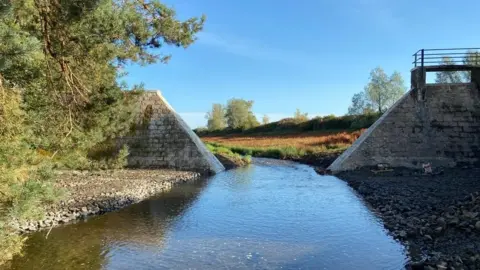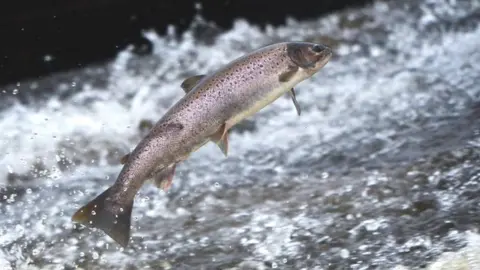Century-old Garlogie Dam removal to help for salmon revival
 SEPA
SEPAAtlantic salmon will be able to access parts of the River Dee for the first time in a century following the removal of a dam.
The demolition of the Garlogie Dam gives salmon access to 20km (12.4 miles) of spawning habitat.
The work will also restore burn and riverbank habitats which were submerged below a reservoir for over 100 years.
Sections of the dam have been preserved on either side to reflect the area's industrial heritage.
The project, delivered by the River Dee Trust and the Dee District Salmon Fishery Board, was paid for by the Scottish government's Water Environment Fund.
 SEPA
SEPACabinet Secretary for Transport, Net Zero and Just Transition, Mairi McCallan, said: "This is a great example of the work being carried out across Scotland by rivers trusts and catchment partnerships to breathe life back into our rivers.
"We are investing £4m this year to sustain the work of the Water Environment Fund both in restoring access to rivers for migratory fish and in urban river restoration, which will deliver benefits for biodiversity, climate change adaptation, green space provision, public access and flood management."
Removal of the 5m-high (16.4ft) dam will also allow for habitat restoration of a 3.5 hectare (8.65 acre) site further upstream.
Over the next 12 months, work - including tree planting and wetland restoration - will change the area that was previously the reservoir into a haven for wildlife.
Charlie Perfect, a river restoration specialist at Scottish Environment Protection Agency (Sepal), which administers the fund, said: "As Scotland's climate changes, it's more important than ever that we restore our freshwater habitats to ensure the long-term resilience of wildlife and local communities."
 Jeff J Mitchell
Jeff J MitchellGarlogie Dam on the Dunnett Estate was built in the 1920s to bring electricity to the house and workshops.
Following the expansion of the national grid, the hydropower station was decommissioned.
The River Dee is one of the world's most famous for salmon fishing and is one of Scotland's "Big Four Rivers" alongside the River Spey, River Tweed and River Tay.
Dr Lorraine Hawkins, from the River Dee Trust, said: "Atlantic salmon are critically threatened throughout their range.
"For this species to have a future, many threats need to be addressed and removing man-made barriers to allow them access to natural spawning and rearing grounds is one of the most obvious actions we can take.
"We are delighted to have been able to finally bring this huge collaborative project to fruition and it is a much-needed success for salmon."
